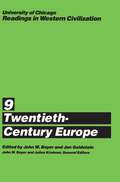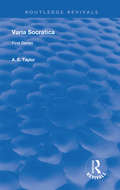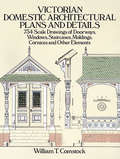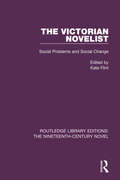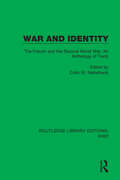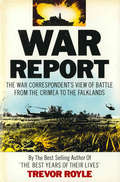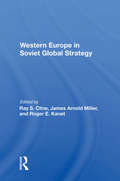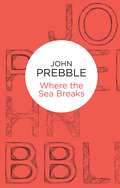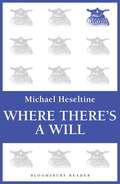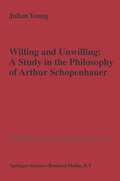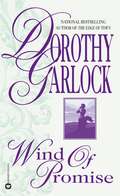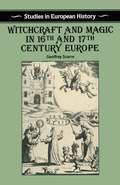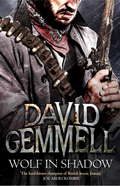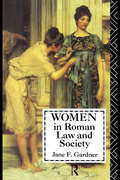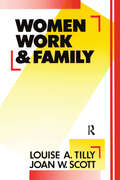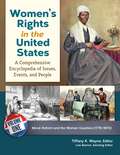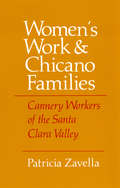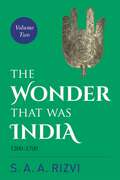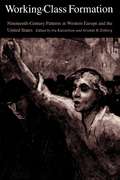- Table View
- List View
University of Chicago Readings in Western Civilization, Volume 9: Twentieth-Century Europe (Readings in Western Civilization #9)
by John W. Boyer Julius Kirshner Jan GoldsteinThe University of Chicago Readings in Western Civilization (nine volumes) makes available to students and teachers a unique selection of primary documents, many in new translations. These readings, prepared for the highly praised Western civilization sequence at the University of Chicago, were chosen by an outstanding group of scholars whose experience teaching that course spans almost four decades. Each volume includes rarely anthologized selections as well as standard, more familiar texts; a bibliography of recommended parallel readings; and introductions providing background for the selections. Beginning with Periclean Athens and concluding with twentieth-century Europe, these source materials enable teachers and students to explore a variety of critical approaches to important events and themes in Western history. Individual volumes provide essential background reading for courses covering specific eras and periods. The complete nine-volume series is ideal for general courses in history and Western civilization sequences.
Varia Socratica: First Series (Routledge Revivals)
by A. E. TaylorPublished in 1987: The following essays form, as their title-page shows, only the first half of a collection which the writer hopes to complete in the course of a few months. Even when completed the whole work is designed to be merely preparatory to another on the interpretation of the Platonic Philosophy, and the materials brought together in the following pages, as well as those which, it is trusted, will form their continuation, were originally intended to appear in the Introduction to that projected work.
Varia Socratica: First Series (Routledge Revivals)
by A. E. TaylorPublished in 1987: The following essays form, as their title-page shows, only the first half of a collection which the writer hopes to complete in the course of a few months. Even when completed the whole work is designed to be merely preparatory to another on the interpretation of the Platonic Philosophy, and the materials brought together in the following pages, as well as those which, it is trusted, will form their continuation, were originally intended to appear in the Introduction to that projected work.
Victorian Domestic Architectural Plans and Details: 734 Scale Drawings of Doorways, Windows, Staircases, Moldings, Cornices, and Other Elements (Dover Architecture)
by William T. ComstockVictorian architecture, with its quirky diversity, eclectic origins, and exuberant ornamentation, continues to exert a strong attraction on today's architects, builders, and homeowners. For those interested in restoring, preserving, or even re-creating Victorian homes, authentic plans and designs are invaluable. This volume, meticulously reproduced from a rare nineteenth-century publication, offers an exceptionally rich pictorial record of actual mid- to late-Victorian designs.Extremely clear and detailed engravings — drawn to scale — present elevations, floor plans, perspectives, and other drawings (in some cases, complete framing plans) for country houses and cottages in a variety of styles: Queen Anne, Eastlake, Elizabethan, Colonial, Jacobean, Southern, Californian, and more. There are even designs for several store and office fronts, with counters, shelving, etc.Supplementing the large number of complete designs are nearly 700 large-scale drawings of virtually every architectural detail, many embodying the unique "gingerbread" that characterizes Victorian buildings. Included are clear, precise renderings of balusters, brackets, dormers, fireplaces, finials, gables, mantels, moldings, newels, porches, rafters, rosettes, staircases, transoms, verandahs, wainscoting, windows, and hundreds of other features.Restorers of old houses, preservationists, students of American architectural history, admirers of Victoriana, and anyone interested in the Victorian Gothic styles that dominated American domestic architecture in the late 1800s will want to have this inexpensive treasury of authentic century-old plans and details.
The Victorian Novelist: Social Problems and Change (Routledge Library Editions: The Nineteenth-Century Novel)
by Kate FlintFirst published in 1987. Many Victorian novels that considered social problems made extensive use of contemporary source material for their descriptions. This book aims to provide a greater acquaintance with this non-literary material — illustrating and exemplifying issues that the authors treated imaginatively. The material is divided into parts dealing with: the industrial north of England, London and the agricultural poor. Extracts from writings that bear directly on the fiction of writers like Dickens and Gaskell are featured, as are Government Blue Books and newspaper reports and articles. This volume also contains articles by Dickens and others, from his magazine, Household Words.
The Victorian Novelist: Social Problems and Change (Routledge Library Editions: The Nineteenth-Century Novel)
by Kate FlintFirst published in 1987. Many Victorian novels that considered social problems made extensive use of contemporary source material for their descriptions. This book aims to provide a greater acquaintance with this non-literary material — illustrating and exemplifying issues that the authors treated imaginatively. The material is divided into parts dealing with: the industrial north of England, London and the agricultural poor. Extracts from writings that bear directly on the fiction of writers like Dickens and Gaskell are featured, as are Government Blue Books and newspaper reports and articles. This volume also contains articles by Dickens and others, from his magazine, Household Words.
War and Identity: The French and the Second World War: An Anthology of Texts (Routledge Library Editions: WW2 #39)
by Colin W. NettelbeckThis book, first published in 1987, examines the elements that constitute the French identity through the experience of the Second World War – a constant point of reference, a landmark to which the collective consciousness returns again and again. The Occupation period and the national humiliation of the French military and political collapse has been perceived as more than a series of traumatic events, and in fact as a reality of mythical proportions that became a symbol of something grander, French identity itself.
War and Identity: The French and the Second World War: An Anthology of Texts (Routledge Library Editions: WW2 #39)
by Colin W. NettelbeckThis book, first published in 1987, examines the elements that constitute the French identity through the experience of the Second World War – a constant point of reference, a landmark to which the collective consciousness returns again and again. The Occupation period and the national humiliation of the French military and political collapse has been perceived as more than a series of traumatic events, and in fact as a reality of mythical proportions that became a symbol of something grander, French identity itself.
War Report: The War Correspondent's View of Battle from the Crimea to the Falklands
by Trevor RoyleWhenever man has gone to war in modern times there has been no shortage of men and women to write about his exploits. They were known as war correspondents, a type of journalists whom General Wolseley called 'the newly invented curse to armies'. This study of the war correspondent's view of war traces the story from Russell's pioneering work for The Times in the Crimea to the assorted press, radio and television journalists who accompanied the British task force to the Falklands in 1982. In particular, it investigates the lives and careers of six of the greatest war correspondents of all time: G W Steevens, who accompanied Kitchener to the Sudan and who introduced the 'colour story' to war reporting; Edgar Wallace, the future thriller writer who scooped the rest of the world at the end of the Boer War; Charles á Court Repington, the military correspondent who exposed the scandal of the shortage of shells in 1915; Claud Cockburn, a communist who adopted a self-confessed partisan approach during the Spanish Civil War; Chester Wilmot, perhaps the greatest of radio war correspondents who brought the Second World War into the living-rooms of Britain; James Cameron, a pacifist who uncovered stories of atrocities in Korea and who demanded to be published and damned. There also includes a discussion on the problems of using television to cover modern war.
Western Europe In Soviet Global Strategy
by Ray S. ClineSoviet global strategy, long established and well understood by the Kremlin leaders, is to intimidate weak and fearful governments, exploit indigenous difficulties, disrupt social order, and promote communist revolutions. In this volume, European and American scholars describe the USSR's land and sea targets on and surrounding West Europe, where t
Western Europe In Soviet Global Strategy
by Ray S. ClineSoviet global strategy, long established and well understood by the Kremlin leaders, is to intimidate weak and fearful governments, exploit indigenous difficulties, disrupt social order, and promote communist revolutions. In this volume, European and American scholars describe the USSR's land and sea targets on and surrounding West Europe, where t
Where the Sea Breaks (The\scottish Collection)
by John PrebbleA German bomber crash-lands on a small Scottish island and the Nazi pilot, with his crew of three, seizes control of the place. Two guns are stripped from the wreckage; an inquisitive collie-dog is killed; a young man is shot dead beside his radio . . . and ‘martial law’ is declared. As thundering seas cut off the island from the mainland, John Prebble works out this wartime story to its terrifying climax. Methodically, brutally the Nazi officer shapes his plans; dumbly, sullenly the Scottish folk hold out and bide their time. Whose nerves will be the first to crack?
Where There's a Will
by Michael HeseltineWhen Where There's a Will was published in the early Spring of 1987 it received not only a highly favourable review coverage but, rarely for a work of political analysis, reached Number One in the Sunday Times best-seller lists. Michael Heseltine revised the book including a totally new chapter, bringing his reflections up to date and giving his thoughts on events of the Spring and Summer of a highly political year. Where There's a Will is a personal testament, a book of ideas, an autobiographical reassessment. It includes many illustrations from Michael Heseltine's personal life and also his views on the need for a British industrial strategy, the real meaning of the North-South divide, the underlying challenge of the inner cities and the proper role and management of government in attacking these and other problems. He faces the reality of continuing high levels of unemployment, sets out his vision of our relationship with the Superpowers. His prescription is one of radical reform, carried out with energy, efficiency and a sense of genuine partnership.
Willing and Unwilling: A Study in the Philosophy of Arthur Schopenhauer (Nijhoff International Philosophy Series #33)
by J.P. YoungWind of Promise (Wind Series #3)
by Dorothy GarlockVanessa is determined to cross the prairies, ford the mighty rivers and climb the Rockies to reach Colorado. But her resolve weakens when a tall, lean stranger as wild as the western wind takes her in his arms. Will surrender to this restless roamer bring her happiness - or will it break her heart forever.
Witchcraft and Magic in Sixteenth- and Seventeenth-Century Europe (Studies in European History)
by Geoffrey ScarreWolf In Shadow: The Graphic No (Jon Shannow Novel #1)
by David Gemmell'THE HARD-BITTEN CHAMPION OF BRITISH HEROIC FANTASY' - Joe Abercrombie 'HEROISM AND HEARTBREAK . . . GEMMELL IS ADRENALINE WITH SOUL' - Brent Weeks It is three hundred years since the world toppled on its axis and civilisation was destroyed. In this savagely reshaped world ruled by brigands and war-makers, a rider seeks a lost city. Pursuing a dream to calm the violence in his soul, Jon Shannow, the brigand slayer, desires only peace. But from the Plague Lands emerges a fresh terror.The Lord of the Pit and his hellborn army seek to plunge mankind into a new demonic era. Seemingly invincible, they make a fatal mistake: they take Shannow's woman for blood sacrifice. And find themselves facing the deadliest warrior of the new age. Jon Shannow - the Jerusalem Man.Novels by David GemmellThe Drenai seriesLegend The King Beyond the GateWaylanderQuest For Lost Heroes Waylander II: In the Realm of the WolfThe First Chronicles of Druss the LegendJon Shannow seriesWolf in ShadowThe Last GuardianBloodstone Stones of Power Ghost KingLast Sword of Power Hawk Queen seriesIronhand's DaughterThe Hawk Eternal Ancient Greece novelsLion of MacedonDark Prince Other novelsKnights of Dark RenownMorningstar
Women in Roman Law and Society
by Jane F. GardnerThe legal situation of the women of ancient Rome was extremely complex, and - since there was no sharp distinction between free woman, freedwoman and slave - the definition of their legal position is often heard. Basing her lively analysis on detailed study of literary and epigraphic material, Jane F. Gardner explores the provisions of the Roman laws as they related to women.Dr Gardner describes the ways in which the laws affected women throughout their lives - in families, as daughters, wives and parents; as heiresses and testators; as owners and controllers of property; and as workers. She looks with particular attention at the ways in which the strict letter of the law came to be modified, softened, circumvented, and even changed, pointing out that the laws themselves tell us as much about the economic situation of women and the range of opportunities available to them outside the home.
Women in Roman Law and Society
by Jane F. GardnerThe legal situation of the women of ancient Rome was extremely complex, and - since there was no sharp distinction between free woman, freedwoman and slave - the definition of their legal position is often heard. Basing her lively analysis on detailed study of literary and epigraphic material, Jane F. Gardner explores the provisions of the Roman laws as they related to women.Dr Gardner describes the ways in which the laws affected women throughout their lives - in families, as daughters, wives and parents; as heiresses and testators; as owners and controllers of property; and as workers. She looks with particular attention at the ways in which the strict letter of the law came to be modified, softened, circumvented, and even changed, pointing out that the laws themselves tell us as much about the economic situation of women and the range of opportunities available to them outside the home.
Women, Work and Family
by Joan W. Scott Louise A. TillyFirst published in 1987. Routledge is an imprint of Taylor & Francis, an informa company.
Women, Work and Family
by Joan W. Scott Louise A. TillyFirst published in 1987. Routledge is an imprint of Taylor & Francis, an informa company.
Women's Rights in the United States [4 volumes]: A Comprehensive Encyclopedia of Issues, Events, and People [4 volumes]
by Tiffany K. Wayne Lois BannerA comprehensive encyclopedia tracing the history of the women's rights movement in the United States from the American Revolution to the present day.Few realize that the origin of the discussion on women's rights emerged out of the anti-slavery movement of the 19th century, and that suffragists were active in the peace and labor movements long after the right to vote was granted. Thus began the confluence of activism in our country, where the rights of women both followed—and led—the social and political discourse in America. Through 4 volumes and more than 800 entries, editor Tiffany K. Wayne, with advising editor Lois Banner, examine the issues, people, and events of women's activism, from the early period of American history to the present time. This comprehensive reference not only traces the historical evolution of the movement, but also covers current issues affecting women, such as reproductive freedom, political participation, pay equity, violence against women, and gay civil rights.
Women's Work and Chicano Families: Cannery Workers of the Santa Clara Valley (The Anthropology of Contemporary Issues)
by Patricia ZavellaAt the time Women’s Work and Chicano Families: Cannery Workers of the Santa Clara Valley was published, little research had been done on the relationship between the wage labor and household labor of Mexican American women. Drawing on revisionist social theories relating to Chicano family structure as well as on feminist theory, Patricia Zavella paints a compelling picture of the Chicano women who worked in northern California’s fruit and vegetable canneries. Her book combines social history, shop floor ethnography, and in-depth interviews to explore the links between Chicano family life and gender inequality in the labor market.
The Wonder That Was India: Volume 2
by S. A. RizviS. A. A. Rizvi’s The Wonder That Was India (Volume Two) is a groundbreaking enquiry into the history of India during the period of Islamic political dominance in the subcontinent. Through meticulous research and painstaking study, Rizvi pieces together a comprehensive account of the five hundred years between the thirteenth and eighteenth centuries, detailing the political histories of the Arabs, Turks, Afghans and Mughals. From his exploration of the social and economic conditions, the state, religion and the fine arts, a vibrant picture emerges of a massive and fertile exchange that would influence the destiny of more than a billion people. This volume, along with A. L. Basham’s classic The Wonder That Was India (Volume One), offers an extensive and engrossing view of the pre-colonial history of India.
Working-Class Formation: Ninteenth-Century Patterns in Western Europe and the United States
by Ira Katznelson Aristide R. ZolbergApplying an original theoretical framework, an international group of historians and social scientists here explores how class, rather than other social bonds, became central to the ideologies, dispositions, and actions of working people, and how this process was translated into diverse institutional legacies and political outcomes. Focusing principally on France. Germany, and the United States, the contributors examine the historically contingent connections between class, as objectively structured and experienced, and collective perceptions and responses as they develop in work, community, and politics. Following Ira Katznelson's introduction of the analytical concepts, William H. Sewell, Jr., Michelle Perrot, and Alain Cottereau discuss France; Amy Bridges and Martin Shefter, the United States; and Jargen Kocka and Mary Nolan, Germany. The conclusion by Aristide R. Zolberg comments on working-class formation up to World War I, including developments in Great Britain, and challenges conventional wisdom about class and politics in the industrializing West.
